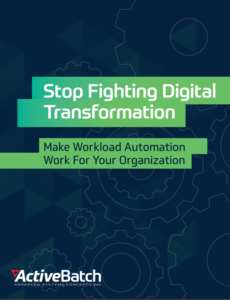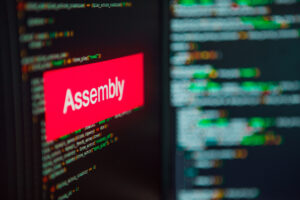IT modernization hinges on a successful automation strategy
IT modernization is critical to staying competitive in our increasingly digital world. But modernization projects fail at a surprisingly high rate. Automation can mitigate some of the biggest hurdles to modernization.

IT modernization is critical to staying competitive in our increasingly digital world. But modernization projects are failing at a surprising rate. Automation can help mitigate some of the biggest hurdles to modernization.
In recent years, digital transformation initiatives have accelerated. Redefining business processes, services and day-to-day operations is necessary to future-proof your organization in a digitally dependent world.
CIOs are increasing efforts to modernize IT to support these initiatives and new business needs. Spiceworks’ Ziff Davis reports that 47% of organizations will be increasing IT spend, in part to modernize IT infrastructure.
However, IT modernization efforts are not always successful. Modernization can be disruptive and complex, especially for organizations that rely on legacy systems. IDG Research Services found that only 25% of IT modernization projects achieved their goals.
Here, we’ll cover the complementary relationship between digital transformation and IT modernization, learn what can stand in the way of achieving modernization and discuss the role of properly implemented automation in bringing your organization forward in time.
IT modernization vs. digital transformation
Digital transformation refers to business strategies that recreate processes, services, day-to-day operations and even business models using new technologies. For example, Netflix used to mail out DVDs until it leveraged broadband (new at the time) to redefine its business model as the world’s first streaming service. In this context, digital transformation is a broad enterprise strategy, of which IT modernization is a key part.
IT modernization refers to upgrading or replacing existing technologies, tools or systems to support business goals and cybersecurity requirements. Transitioning from a legacy mainframe to a hybrid cloud infrastructure facilitated by various cloud services is one example. IT modernization efforts improve operational efficiency and reliability, transform the business user experience and often reduce operating costs. Application modernization, a category of IT modernization, focuses on replacing legacy applications used in IT or business departments.
Why modernize now?
Typically, IT systems and software become more expensive to maintain as they age. Vendors stop releasing upgrades and security patches while expertise in those legacy tools becomes difficult to find. Most legacy solutions were not designed to integrate with modern or emerging technologies and require ad-hoc or custom scripting to manage sensitive data across disparate tools.
Modernization is especially important for large enterprises that began digitizing decades ago. In the context of federal governments or agencies such as the Department of Defense, you may have heard stories of the negative outcomes of relying on floppy disks or other outmoded technologies. Many institutions maintain information systems that date back to the 1970s.
Trying to stay competitive — or simply functional — with old technologies is like driving on tires that have been rotting for years. It might be possible for a short time, but it’s dangerous and can stop your journey altogether.
Don’t let IT complexity hamper your digital goals
Get the latest trends and data on what’s driving transformation and how IT teams address these challenges.
Roadblocks in building an IT modernization strategy
You need to modernize to integrate new tools and technologies into existing environments. However, you might come up against challenges as you attempt to streamline and upgrade, including:
- Establishing governance
- Integrating disparate data sources
- Migrating sensitive data or workloads
- Optimizing your IT ecosystem for cost, process automation and scalability
Successful IT modernization, for many organizations, requires integrating disparate technologies and managing processes, data and apps across legacy on-premises systems and cloud-based infrastructure and applications. For a majority of IT teams, this integration poses the greatest challenge to modernization — but it’s essential to push forward as your competitors start to prioritize cloud computing, machine learning and other advancements.
Automation: A core function in the modernization roadmap
The volume of projects IT teams are responsible for continues to grow as businesses become more reliant on IT. A protracted skills gap and rapidly evolving technology are creating more technical debt for some companies.
At the same time, IT systems are becoming more complex, absorbing more resources to keep the lights on.
IT automation projects have jumped to the forefront to remedy both the skill shortage and complexity struggles, but these attempts are often piecemeal. Implementing singular-focus automation tools, vendor-specific schedulers, data center automation and RPA to automate specific tasks can create silos. Ironically, this approach can lead to more complexity and greater integration challenges.
The answer is finding a powerful tool that can drive efficiency across your entire tech stack and all your end-to-end processes.
Workload automation (WLA) software supports effective modernization and transformation methodologies. It’s often highly extensible, enabling IT teams to manage data, processes and services across disparate endpoints. Moreover, a sophisticated platform can connect applications and services with infrastructure resources. For example, some tools can leverage artificial intelligence to manage workloads across servers and provision and de-provision cloud-based resources.
Workload automation platforms enable several key components of modernization.
Workload migration
WLA software has change management capabilities that make managing processes and objects between environments easy. Pushing changes from QA or dev environments into a production environment, for example, becomes simpler. Users can also compare and synchronize job schedulers across on-premises and cloud-based environments.
IT modernization often includes cloud-based infrastructure, platform and software deployment, which requires workloads to run in cloud environments. WLA can provide reliable migrations between those disparate IT environments.
Centralized monitoring
By automating and managing processes from a central point of control, IT teams can also monitor processes and resources from a centralized location. WLA solutions provide real-time monitoring, alerting and auto-remediation capabilities for cross-platform processes. Features might include centralized log repositories and reporting capabilities for faster troubleshooting. Leveraging these capabilities can drastically reduce the time IT spends fighting fires, giving them more time to complete key DevOps projects.
Extensible connections
Integrating disparate endpoints and data sources is a big hurdle for IT teams, especially as modernization initiatives introduce new platforms and technologies. In some cases, WLA vendors can provide direct, programmatic access to major platforms and systems, including ERP and data warehousing.
Programmatic integrations with common platforms can be supplemented with universal connectors supporting common IT and business tasks regardless of the technologies used.
Some WLA solutions are developing powerful new API capabilities. Users can build reusable REST API adapters based on pre-built or customized templates. According to Mulesoft, IT organizations that use APIs for integration are 69% less likely to experience integration challenges.
High availability failover
Modernization projects are complicated. Faulty server configurations and ill-conceived implementations can cause unexpected downtime that impacts your ability to hit milestones on time.
WLA platforms often rely on multiple schedulers and execution agents to process workloads. Workloads might thus be rapidly moved to new servers or environments when issues arise, keeping processes running smoothly even in the event of an outage. Passive job schedulers can monitor active job schedulers and likewise take control when they detect issues.
Simplified governance
Establishing a standardized governance framework across disparate environments isn’t easy. Centralized automation platforms simplify compliance efforts by enabling IT to enforce policies from a single point of control. This can include requiring certain protocols for sensitive file transfers, monitoring endpoint connections and providing full audit trails for all events, actions and users within the environment.
Find the right workload automation provider
The first step in finding your best-fit WLA solution is to think of it as an orchestration engine. Broad functionality and integration capabilities will enable your users to automate virtually any IT or business use case, regardless of whether the endpoints are on-premises or in a public or private cloud.
Furthermore, a low-code WLA platform with reusable templates and pre-built connectors can rapidly integrate new technologies and enable end users at all skill levels to assemble end-to-end workflows that span infrastructure and service layers.
WLA can also circumvent and simplify many modernization requirements. Let’s say your IT team still relies on OpenVMS to manage batch processes. A WLA solution can trigger processes within OpenVMS, in some cases removing the need to replace the legacy software. The same is true for COBOL-based systems, cron schedulers and any other legacy tools past its heyday.
You’ll know when you’ve found your perfect modernization match in a WLA provider when your vetting proves it supports a wide range of use cases and can consolidate your legacy tools into a single, low-code solution.
Explore what your infrastructure could look like — and what it could feel like to no longer worry about the risks of holding on to legacy tools. See how ActiveBatch can simplify your modernization project.
IT modernization strategy FAQs
Modernization in information technology refers to replacing outdated systems, software and applications, often in IT departments. Hardware and software become more difficult to maintain as they age, creating additional costs while becoming less reliable. Moreover, it can be difficult to integrate new technologies into legacy information systems, often requiring custom scripts and ad hoc workarounds that build technical debt while increasing the risk of downtime.
Discover the 5 essentials of effective automation.
IT infrastructure modernization refers to updating and upgrading an organization’s systems, including hardware, software, networks and data management protocols. Modernization can encompass a smooth transition to cloud-based services, implementation of virtualization techniques and adoption of more robust security measures.
Read more about key trends for IT infrastructure and operations management.
Organizations modernize their technological infrastructure to align IT assets with current business needs and future goals. For most, the business objectives are:
1. Enhance efficiency and agility
Modern technologies enable organizations to operate more efficiently with automation and better resource utilization. IT teams may look to increase processing speeds, reduce downtime and develop more agile responses to customer needs, stakeholder interests and market changes.
2. Improve the customer experience
Up-to-date technology gives customers a more reliable experience with personalized interactions, better interfaces and faster response times. As a result, they’re likely to be more satisfied and loyal.
3. Reduce costs
Modernizing technology can create significant cost savings over time. Newer technologies require less maintenance and consumer fewer resources. Cloud technology, in particular, reduces the need for expensive hardware and on-site infrastructure.
4. Advance risk management and security
As cyber threats evolve, modern technology is crucial for reducing vulnerabilities. Outdated systems are open to attacks and may make it difficult to comply with today’s data protection regulations.
5. Become more flexible
Modernized systems are typically more scalable and adaptable, so businesses can grow or pivot without constraint. Flexibility is key for exploring new business models or markets.
6. Support sustainability
Environmental impact is a big concern for forward-thinking organizations. New technology solutions can help with energy efficiency and lower your carbon footprint.
Learn more about how autonomous IT operations support automation.
Yes, automation can help simplify modernization projects by reducing the need for manual tasks, giving IT teams more time to spend on modernization efforts. Automation platforms can also provide the capabilities necessary to integrate and manage other solutions. By triggering processes through a single solution, legacy tools can be consolidated or coordinated, in many cases removing the need to rip and replace outdated software.
Discover how to reduce IT complexity by centralizing your IT automation.
Ready to simplify your data warehousing with workload automation?
Schedule a demo to watch our experts run jobs that match your business requirements in ActiveBatch. Get your questions answered and learn how easy it is to build and maintain your jobs.








